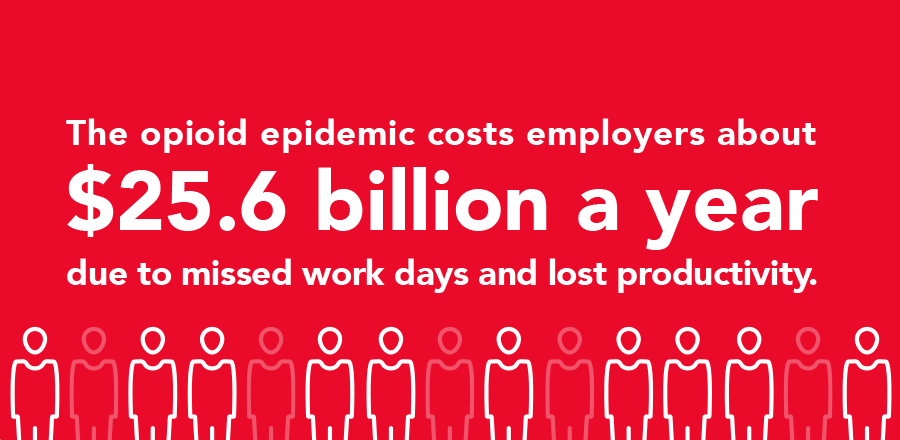
Published September 2019
The opioid crisis is no longer just a crisis–it’s a full-blown epidemic. Every day, more than 130 people die from opioid overdoses in the U.S. That’s one death every 11 minutes. And the problem hits close to home in the Northeast. On average, New England states spend over 25% more than other states on opioid-related costs. Since this epidemic directly affects businesses’ profitability, it’s important to give your clients the tools they need to keep their businesses safe and employees healthy.
 What's happening?
What's happening?
Addiction isn’t confined to at-risk communities. It often begin when opioids are prescribed for things like chronic pain and recovery from surgery. When patients aren’t given the resources they need to properly take and manage opioids, the results can be shocking. “It’s not a defect of character,” says Bill Brewster, VP of Harvard Pilgrim’s New Hampshire market, “It is like any other illness that anybody has.” Dr. Brewster has seen the effects of this issue firsthand, when his son struggled with an opioid addiction. “This is not them; this is us,” Dr. Brewster states in The New Hampshire Union Leader. “We’re all in this together.”
21-29% of patients who were prescribed opioids for chronic pain ended up misusing them according to a review of health care data from 2015. And this misuse is rising in the U.S. About $78.5 billion a year is spent on prescription opioid misuse alone, which includes the cost of health care, lost productivity, addiction treatment and criminal justice involvement, according to the Centers for Disease Control and Prevention. In fact, 1/3 of Americans say they know someone who is or has been addicted to opioids, so it’s important for your clients to consider that an employee may have a family member who’s struggling—and who could be on their health plan.
 Hidden financial risks
Hidden financial risks
An employee working under the influence is a risk to your client’s business and other employees, whether they’re operating heavy machinery, interacting with a client or writing up a proposal. But while the physical risks of drug abuse can be apparent, the financial risks can be harder to see. Employees prescribed even one opioid pill were found to cost four times more in workers’ comp claims than those who weren’t prescribed any. And employers of all settings are facing increasing costs. Missed work days and lost productivity due to the abuse of prescription painkillers costs employers an estimated $25.6 billion a year.

 Prevention and support
Prevention and support
Health insurance companies can be a critical advocate to empower businesses and employees impacted by opioids. They can partner with doctors and pharmacists to work together when a patient requires opioids to make sure non-opioid options are considered and covered as alternatives. Many offer free benefits that can help employees or their family members on a personal level, like nurse care managers who can work with their members to find other solutions for chronic pain, and personal health coaches who can help manage a patient’s prescription opioid intake. Health insurance companies can also be a good resource for individuals looking for support groups and other services dedicated to overcoming addiction.
While the economic burden is clear, what’s happening on the ground floor is not. Addiction is personal, emotional and often difficult to notice. On top of that, a person’s health is a private matter, so confronting someone about a suspected addiction could result in legal issues for your clients. But by offering them a health insurance company that will partner with them to offer resources for prevention and addiction support, you can help them keep their businesses and their employees safe from risk.
See what services and solutions you can offer your clients to prevent addiction, treat a problem, and find support in the opioid epidemic.
To confirm eligibility for any programs or services mentioned in this article as it relates to your specific health plan, please reach out to your account executive or HR benefits team. You may also speak to our member services team at (888)-333-4742 or by sending a secure email. And for plan details and other member resources, log in to the member portal.